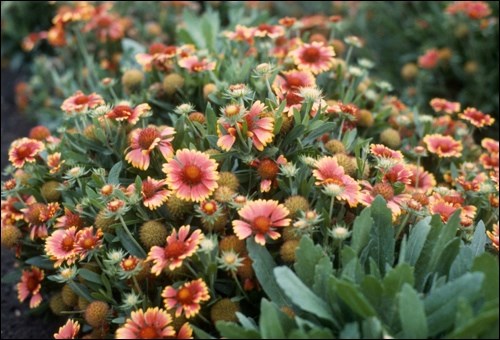Gaillardia remind me of a faithful dog that demands little, works its heart out in hot sun with little water, is determinedly cheerful, but dies much too soon. It’s all due to genetics. Most hybrids (listed as Gaillardia grandiflora) are crosses between the annual blanketflower (G. pulchella) and the perennial blanketflower (G. aristata). They inherit their cold tolerance and somewhat perennial nature from their perennial parent. Their exceptionally long bloom period and heat tolerance comes from their annual parent, but so does their tendency to be short lived. Expect two years and if they manage four years you’ll be ecstatic.
Gaillardia is native to the North American prairies, and the common name, blanketflower, suggests the colours found in blankets of indigenous peoples of the American southwest: from yellow to orange, bronze, maroon, red and burgundy. It may also have been derived from the way in which these flowers once blanketed the prairies.
The solitary, daisy-like flowers of the native species (G. aristata) are about six centimetres in diameter and consist of long narrow, yellow-orange petals (the ray flowers) that are toothed at their tips and surround short, brownish-purple disc flowers in the center. Found in the Canadian prairie grasslands and drier uplands, they’re in bloom by mid to late June and continue through August. The plants are erect but somewhat sprawling, and vary in height from 30 to 90 centimetres. The native species lives three to four years but reseeds easily. It is usually available only at nurseries specializing in native plants and is (sadly) seldom seen in gardens.
Blanketflowers are adapted to full sun and well drained soils, surviving with little care. They do poorly in heavy clay. They are not long lived, so leave the soil around them un-mulched so they can self-seed. Cutting back flowering stems prior to hard frost encourages new basal buds. They are slow to resume growth in the spring, so be patient and refrain from digging them out. Deadhead to prolong bloom. Divide by making a vertical cut along the side of a clump in mid-summer. New plants will form where the roots were severed.
Gaillardias are excellent in the “hot” border, a rock garden, in containers, as a cut flower, and for naturalizing where they can self-seed. They are a butterfly and bee nectar source.
Burgundy and Goblin, both G. grandiflorahybrids, have been grown in prairie gardens for decades.‘Burgundy (Zone 2) is a vigorous plant, with single, dark wine-red flowers, seven centimetres cm in diameter, varying in height from 60 to 90 centimetres with a semi-compact form. Goblin (Zone 2) is a compact, dwarf, mound-like cultivar with grey-green foliage, reaching only 30 to 45 centimetres. The single flowers have red petals with yellow tips. Well suited to the front of the perennial border or a rock garden, it flowers its first year from seed.
The newer cultivars have less been widely tested on the prairies. “Treat them as annuals” and place them in more protected locations.
Arizona Sun (Zone 3), a 2005 All America Selections winner, has eight centimetre diameter, bright mahogany-red flowers with yellow tips. It’s a compact, dwarf plant, with green foliage, only 25 centimetres tall, blooming from June to September.
Summer Kiss(Zone 3), a unique peachy-apricot color with hints of yellow and almost ruffled petal tips, is a seedling selection from Goblin. Low growing (45-60 centimetres), compact and upright, it has medium green foliage. It blooms in mid-summer with five centimetre diameter flowers.
Fanfare(Zone 3)has a velvet-like scarlet center surrounded by tubular orange-red ray petals with bright yellow tips, giving it an almost lacy appearance. It has a compact, mounded form and a height of 45-60 centimtres. It is very floriferous and excellent for cutting with flowers on erect sturdy stems.
Sara Williams is the author of the newly revised Creating the Prairie Xeriscape and the Saskatoon Forestry Farm Park & Zoo: A Photographic History. In 2015, she will be leading threegarden tours: to Morocco, Turkey and Ireland. For more information, call Ruth at 1-888-778-2378.




